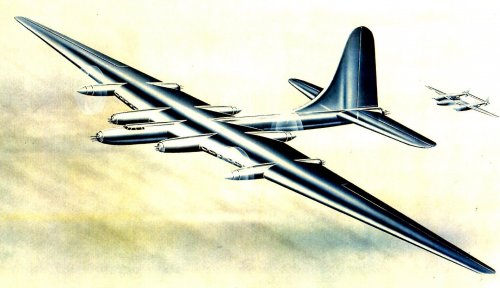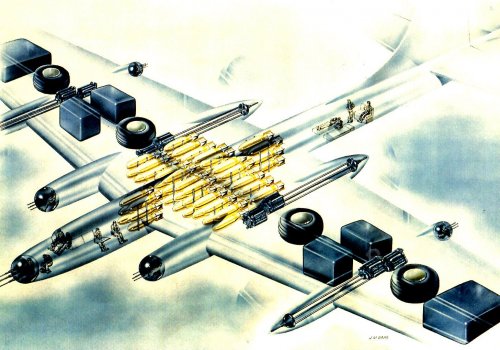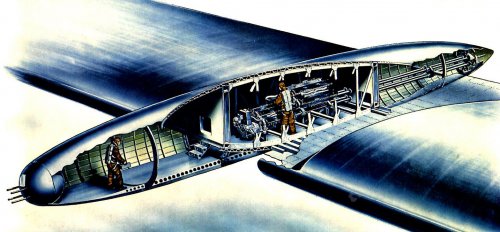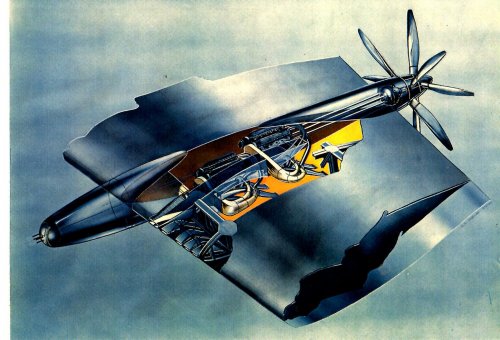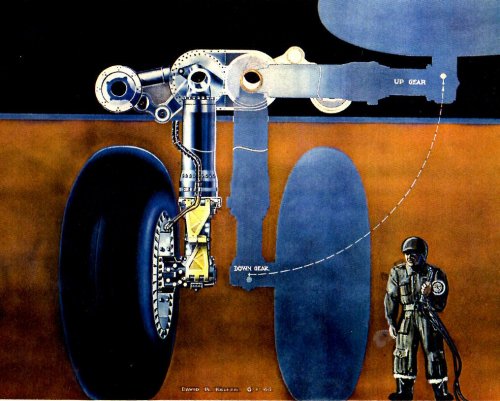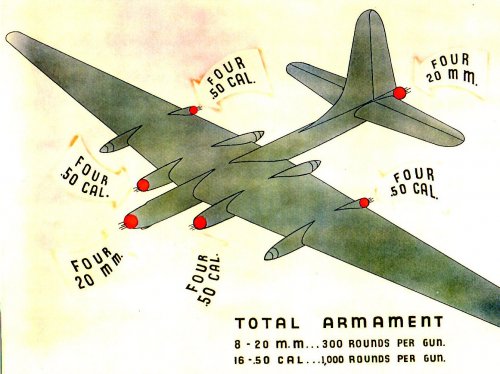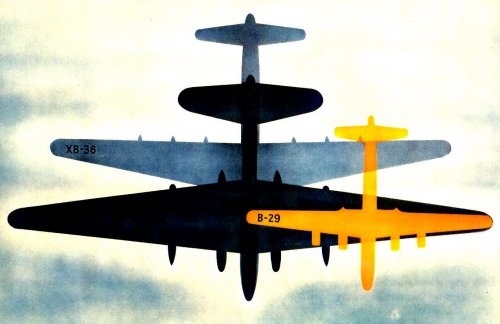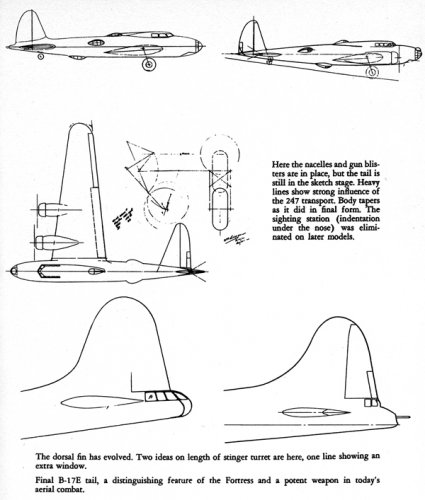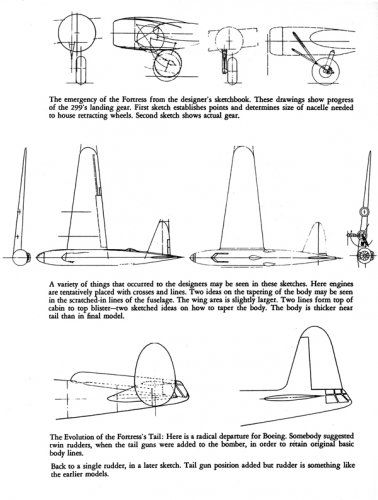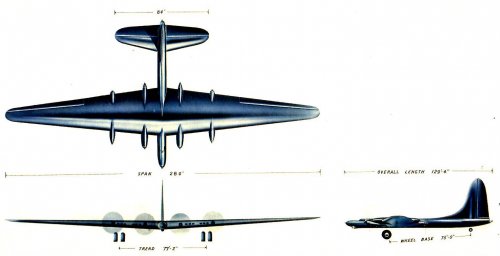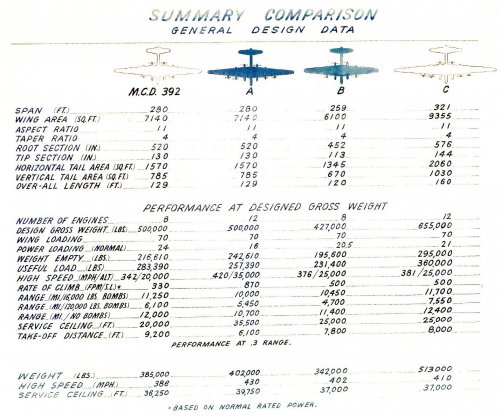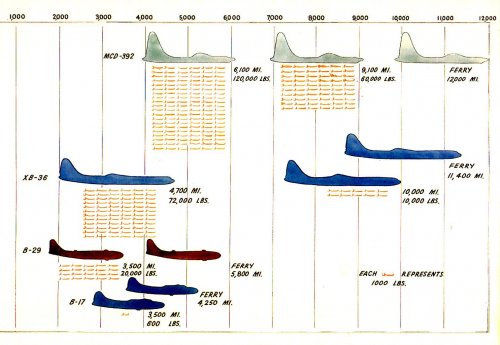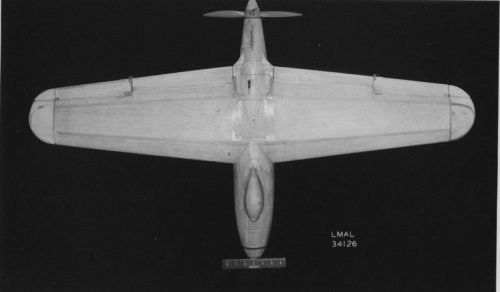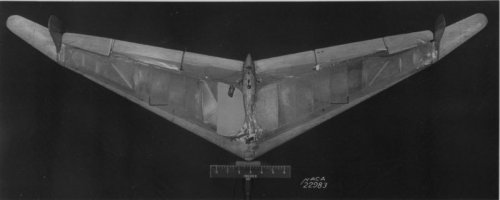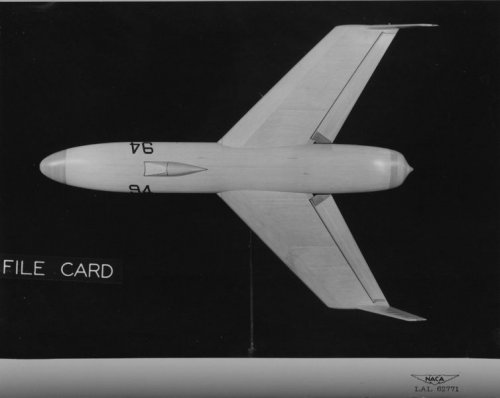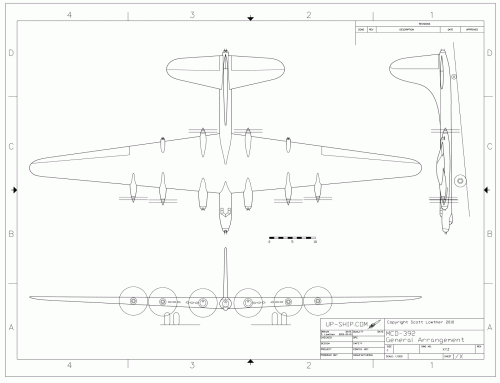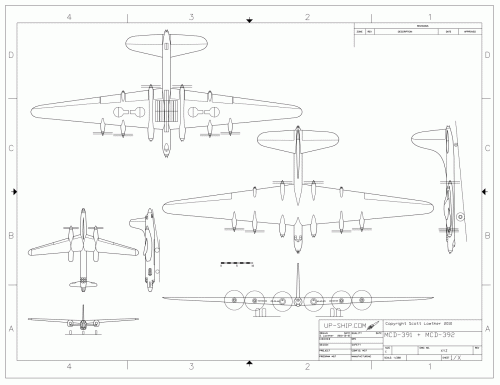The recent discussion of BuAer designs reminded me to pull a file on an AAF Materiel Comd design study for a super-heavy bomber. The paperwork comes from NARA RG 342, Box 2178. There are two Engineering Division memos (4261-3-4, dtd 12 May 44, and 4261-3-5, dtd 29 Jun 44), and they consider aircraft powered by up to twelve (!) Allison V-3420 engines, wing spans up to 321 feet, and gross weights of up to 655,000 lbs. The image is taken from a contemporary but undated report prepared by the Wright Fld Aircraft Laboratory.
You are using an out of date browser. It may not display this or other websites correctly.
You should upgrade or use an alternative browser.
You should upgrade or use an alternative browser.
AAF Materiel Command Design MCD 392 (MX-423)
- Thread starter Clioman
- Start date
- Joined
- 25 June 2009
- Messages
- 13,737
- Reaction score
- 2,918
Clioman said:Sorry if the image is too large...will post more if there's interest.
Of course there is!!! Isn't this what we're all here for, anyway?
Clioman said:Sorry if the image is too large...
What is this "image too large" of which you speak? Ain't no such concept.
will post more if there's interest.
Damn straight there's interest!
Clioman said:Sorry if the image is too large...will post more if there's interest.
Yes, please! B) There's interest. Plus, the image size isn't too large.
- Joined
- 3 June 2006
- Messages
- 2,830
- Reaction score
- 2,500
Amazing,  B)
B)
but in "img105.jpg" I only count 8 engines. ???
Edit:
Ok, "up to twelve (!) Allison V-3420 engines", so that means similar concepts had more engines.
but in "img105.jpg" I only count 8 engines. ???
Edit:
Ok, "up to twelve (!) Allison V-3420 engines", so that means similar concepts had more engines.
- Joined
- 25 June 2009
- Messages
- 13,737
- Reaction score
- 2,918
lark said:Regarding the fin and rudder , could there be
some Boeing influence..?
Don't forget that variants Y1B-17 to B-17D had a different fin. Could also have been the other way round... like the AAF requiring a tail redesign.
Steve Pace
Aviation History Writer
- Joined
- 6 January 2013
- Messages
- 2,266
- Reaction score
- 166
My Douglas list has D-392 as a DC-3-392 (C-50D)?Clioman said:The recent discussion of BuAer designs reminded me to pull a file on an AAF Materiel Comd design study for a super-heavy bomber. The paperwork comes from NARA RG 342, Box 2178. There are two Engineering Division memos (4261-3-4, dtd 12 May 44, and 4261-3-5, dtd 29 Jun 44), and they consider aircraft powered by up to twelve (!) Allison V-3420 engines, wing spans up to 321 feet, and gross weights of up to 655,000 lbs. The image is taken from a contemporary but undated report prepared by the Wright Fld Aircraft Laboratory.
J
joncarrfarrelly
Guest
Stargazer2006 said:lark said:Regarding the fin and rudder , could there be
some Boeing influence..?
Don't forget that variants Y1B-17 to B-17D had a different fin. Could also have been the other way round... like the AAF requiring a tail redesign.
The distinctive 'Boeing' tail design first appeared on the production Model 307 Stratoliner and was then added to the Model 299-O (B-17E, F, G).
The enlarged tail was the result of lateral stability problems with the B-17C type vertical tail on the first 307s.
The 299 rear-end redesign, primarily in order to incorporate rear armament, went through several iterations.
Attachments
- Joined
- 25 June 2009
- Messages
- 13,737
- Reaction score
- 2,918
Thank you so much Jon for this very informative document! What was the source?
Where did you get the notion that "MCD" had anything to do with Douglas???!!!
McDonnell and Douglas were two competing companies at the time, so D- or DS-, but "MCD"??
XB-70 Guy said:My Douglas list has D-392 as a DC-3-392 (C-50D)?
Where did you get the notion that "MCD" had anything to do with Douglas???!!!
McDonnell and Douglas were two competing companies at the time, so D- or DS-, but "MCD"??
MCD would seem to stand for Material Command Design.
Steve Pace
Aviation History Writer
- Joined
- 6 January 2013
- Messages
- 2,266
- Reaction score
- 166
Did I type MDC? I don't think so. I typed D-392.Stargazer2006 said:Thank you so much Jon for this very informative document! What was the source?
XB-70 Guy said:My Douglas list has D-392 as a DC-3-392 (C-50D)?
Where did you get the notion that "MCD" had anything to do with Douglas???!!!
McDonnell and Douglas were two competing companies at the time, so D- or DS-, but "MCD"??
J
joncarrfarrelly
Guest
Stargazer2006 said:Thank you so much Jon for this very informative document! What was the source?
pages 46 & 47, Flying Fortress: The Story of the Boeing Bomber, Thomas Collison, Charles Scribner's Sons, New York 1943.
Scott's right. MCD = Materiel Command Design. (Note the spelling, BTW.) The Materiel Command (Hq'd @ Wright Field, Ohio) had an in-house design staff, just as BuAer did, and they both produced design packages intended to suggest what might meet their respective Service's needs, or simply what might be technically feasible for a given requirement. For a time BuAer actually attached the design package to the Request for Proposals...saying, in effect, "tell us what you'd charge to build something like this." BuAer stopped doing that when the management realized that it stiffled the contractors' creativity.
I don't know if anyone has ever tried to draw up a list of MCD numbers. As in the case of the MX (for Materiel - Experimental) numbers issue list, the original MCD registry has not surfaced. It had to have existed in some form, if only to keep track of what the latest number was, but whether it still survives is an open question. Anyone have any thoughts?
I don't know if anyone has ever tried to draw up a list of MCD numbers. As in the case of the MX (for Materiel - Experimental) numbers issue list, the original MCD registry has not surfaced. It had to have existed in some form, if only to keep track of what the latest number was, but whether it still survives is an open question. Anyone have any thoughts?
- Joined
- 26 May 2006
- Messages
- 32,642
- Reaction score
- 11,820
Hi,
I think the number 392 was a Convair design,that is because the
MX-423 was a preliminary design for the MX-716,or Convair XA-44
and XB-53,I suggest that it was P.392 as Convair second series
or third as I know,please see;
http://www.designation-systems.net/usmilav/mx/1-499.html
http://www.designation-systems.net/usmilav/mx/500-999.html
I think the number 392 was a Convair design,that is because the
MX-423 was a preliminary design for the MX-716,or Convair XA-44
and XB-53,I suggest that it was P.392 as Convair second series
or third as I know,please see;
http://www.designation-systems.net/usmilav/mx/1-499.html
http://www.designation-systems.net/usmilav/mx/500-999.html
- Joined
- 25 June 2009
- Messages
- 13,737
- Reaction score
- 2,918
Can't understand why you guys are desperately trying to make a connection between "AAF Materiel Command Design MCD 392" and a company model number!! Is it difficult to accept that it probably was just the 392nd design issued by the Air Force's Material Command?! ???
Clioman said:(Note the spelling, BTW.)
A never-ended problem for me.
Thanks for posting this stuff! Any chance of three-views?
Steve Pace
Aviation History Writer
- Joined
- 6 January 2013
- Messages
- 2,266
- Reaction score
- 166
Is there a numerical list for the AAF Materiel Command Design entity? SPStargazer2006 said:Can't understand why you guys are desperately trying to make a connection between "AAF Materiel Command Design MCD 392" and a company model number!! Is it difficult to accept that it probably was just the 392nd design issued by the Air Force's Material Command?! ???
In response to Hesham's question -- MCD 392 was strictly an in-house Materiel Comd effort and clearly linked to MX-423 --the Engineering Division memos that I mentioned in the initial entry are both labeled as such -- but I suspect that MX-423 started out as a generic 'catch all' for bomber design studies (maybe solely for funding or staff workload allocations?), and later focused on forward-swept studies. I say that because I have a file somewhere on the XA-44/XB-53 (I promised to look for it a while back, and will redouble my efforts now that this has come up) with material copied from the RG 342 folder @ NARA and the initial entry is a MCD-numbered study for a twin-prop driven, forward-swept, medium-weight attack bomber--I don't now recall the exact number, but I'm 99% certain that it was not MCD 392. (IIRC, the wing was swept forward @ 12 degrees, as was the subsequent XA-44. The XB-53 was a 'do-over' effort with a greater sweep angle and pronounced dihedral.)
Re Scott's question, yes, I have a 3-view, but the quality of the copy is truly awful: it was xeroxed @ NARA during a trip I made there in the 1980s.
Re Scott's question, yes, I have a 3-view, but the quality of the copy is truly awful: it was xeroxed @ NARA during a trip I made there in the 1980s.
Clioman said:I have a file somewhere on the XA-44/XB-53 (I promised to look for it a while back, and will redouble my efforts now that this has come up) with material copied from the RG 342 folder @ NARA and the initial entry is a MCD-numbered study for a twin-prop driven, forward-swept, medium-weight attack bomber

I have a 3-view, but the quality of the copy is truly awful: it was xeroxed @ NARA during a trip I made there in the 1980s.
Such things can be fixed, so long as the outlines are visible.
A few more pages from the undated Aircraft Laboratory illustrated report that paralleled the Engineering Division's memos. The 3-view shows the "basic" eight-engined MCD 392 w/280' wingspan. The 29 June 44 Engineering Div memo has a 3-view of the 12-engined "A" version (same wingspan) shown on the comparison shown below - that's the 'truly awful' drawing I mentioned above. The memo notes that the extra engines were added to the analysis to improve the design's rate of climb; gross weight for the 12-engined version was given as 655,000 lbs., with a maximum bomb load of 120,000 lbs.
Attachments
- Joined
- 26 May 2006
- Messages
- 32,642
- Reaction score
- 11,820
Hi,
and why we focus only on this,in NASA site anther two examples,
one is Model-321 of 1943 and the second for Model-364 of 1941
to a tailless aircraft,this series have no sense,and note that in
the Model-364 they wrote [ Material Division ],may be it was
for a company,I suggest the Boeing or Convair.
http://crgis.ndc.nasa.gov/historic/Additional_Photos_for_12-Foot_Low_Speed_Tunnel_3#Model_.23321
and why we focus only on this,in NASA site anther two examples,
one is Model-321 of 1943 and the second for Model-364 of 1941
to a tailless aircraft,this series have no sense,and note that in
the Model-364 they wrote [ Material Division ],may be it was
for a company,I suggest the Boeing or Convair.
http://crgis.ndc.nasa.gov/historic/Additional_Photos_for_12-Foot_Low_Speed_Tunnel_3#Model_.23321
Attachments
Retrofit
ACCESS: Top Secret
- Joined
- 21 February 2007
- Messages
- 642
- Reaction score
- 272
The same can be said of the Model 94, tested in September 1949.
http://crgis.ndc.nasa.gov/historic/File:LAL_62771.jpg
BTW: Model 321 was subject to NACA report ACR No L5K05, dated February 1946 and already mentioned by Hesham in the thread "USA unknown tailless fighter of 1946".
http://ntrs.nasa.gov/archive/nasa/casi.ntrs.nasa.gov/19930092559_1993092559.pdf
http://crgis.ndc.nasa.gov/historic/File:LAL_62771.jpg
BTW: Model 321 was subject to NACA report ACR No L5K05, dated February 1946 and already mentioned by Hesham in the thread "USA unknown tailless fighter of 1946".
http://ntrs.nasa.gov/archive/nasa/casi.ntrs.nasa.gov/19930092559_1993092559.pdf
Attachments
I'd want to be very careful in trying to make sense of the photo captions provided on that NASA website. In some cases, the models have very clear visual linkages to programs resulting in (or following upon) actual aircraft. Many more do not. That's because the NACA wind tunnel complex was used by a wide variety of researchers -- NACA's own employees, military services and government agencies, aircraft and missile manufacturers, academics, and even semi-anonymous private researchers. And the pictures are labeled according to whatever the researcher told NACA to call their model (including nothing at all in, for example, many theoretical studies). When the photo caption says 'Model No. xxx' that may refer to a contractor's design designation, e.g., Boeing 299, to some component (or sub-component) of a military or NACA design program, to a variant sequence in an academic's theoretical study, or to something else entirely. Bottom line: those captions are an amalgam of many researchers' designations, only some of which pertain to programs that proceeded far enough to result in a contractor's model designation or a military aircraft designation series. Caveat inquisitor!
- Joined
- 25 June 2009
- Messages
- 13,737
- Reaction score
- 2,918
hesham said:this series have no sense
Not yet. I'm currently working hard at sorting out all the various NACA and NASA model and test lists and I believe some sense will come out of the whole thing in the end...
Other "orphans": Model 110 (1953) and 110T (1956), Model 142/A/C (a Vertol-related tilt-wing).
But you have to remember that "model" in these archives doesn't necessarily indicate a design number. The word "model" most often indicates a scale model. For instance, "Model 174" was a "Powered Dynamic Model of Boeing XPBB-1 flying boat", it was simply the 174th scale model tested by NACA in its Langley tank facilities.
So stay tuned.
Jos Heyman
ACCESS: Top Secret
- Joined
- 15 February 2007
- Messages
- 597
- Reaction score
- 53
I support Stargazer's comments. You could be looking at a whole load of numbers for the same thing: the manufacturer's number, the NACA project number, the MCD design number etc etc. And for each there could be multiple numbers. In these case of the windtunnel numbers that we are currently floating around, each number could refer to a single file reference in which the result are stored, ie multiple nmbers for the same windtunnel model.
So we got to be very careful or we could end up with a dogs dinner of lists that make no sense.
So we got to be very careful or we could end up with a dogs dinner of lists that make no sense.
- Joined
- 14 June 2006
- Messages
- 2,297
- Reaction score
- 416
Fellows, I'm excited the Early Aircraft Section is brimming with livey discussion !!! Now, back to the original post, for mere mortals, the MCD-392 is described in less details than here on page 101 of the masterful "Cold War Peacemaker" by Pyeatt and Jenkins, from Specialty Press. There it is clearly stated as a Wright Field job. The general configuration idea is stated as aken from the B-19, apart for the engine arrangement.
blackkite said:Cool! Scott.Vertical stabilizer is very large.

Yes, it is. But then, the wings are "over sized" compared to the fuselage, which puts the tail really close to the wings, meaning a relatively small moment arm, meaning the tail would need to be large. On the other hand, the fuselage is small enough compared to the wings that it's *almost" comparable to a flying wing. At which point the vertical tail could be done away with entirely.
Last edited:
Similar threads
-
AAF Materiel Command Design MCD 391 (MX-423)
- Started by Clioman
- Replies: 18
-
Consolidated-Vultee XA-44 (MX-423 and MX-716)
- Started by Clioman
- Replies: 8

